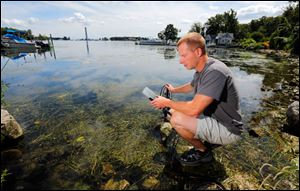
OUTDOORS
Fighting harmful algae in Lake Erie takes a Rocket scientist
10/7/2013
Matt Markey
The Blade/Dave Zapotosky
Buy This Image

Justin Chaffin, who has a doctorate degree from the University of Toledo, tests water at Put-in-Bay. Chaffin says he's always wondered what was in Lake Erie besides walleye and perch.

Matt Markey
PUT-IN-BAY, Ohio — The office wall is starting to get somewhat obscured by the official degrees that hang there, and now, there is a “Dr.” in front of Justin Chaffin’s name on the mail sitting on his desk.
But this is also the same little kid who two decades ago often went fishing in Lake Erie with his dad and wondered what might be out there besides the walleye and perch.
Chaffin, who grew up not far from the lake in the tiny hamlet of Collins, south of Huron, brings that youthful exuberance and innate curiosity to the lab where he now works. As the senior researcher and research coordinator at Stone Lab on South Bass Island, Chaffin is literally behind enemy lines in the war being waged against the harmful blooms of algae that once again are enveloping large sections of western Lake Erie.
“The work is challenging and at times very difficult, but like anything having to do with research, it’s the opportunity to answer that question, that unknown,” Chaffin said. “And with Lake Erie, there’s a lot of them out there.”
In May, Chaffin received his PhD from the University of Toledo, formally making him a Rocket scientist, but he has been at work peering into the world of Lake Erie’s most pressing issues, including the complex and dangerous blue-green algae, for nearly a decade while completing his studies.
Chaffin earned a degree in biology with a minor in chemistry from Bowling Green State University, then a master’s in biology from UT. His doctorate is also in biology from UT’s department of environmental science.
“Coming out of high school, I knew I wanted to do something with science, but I wasn’t exactly sure what,” Chaffin said, who had his interest in the environment piqued by an introductory biology class he took at BGSU’s Firelands campus.
“We were sampling the ponds near campus and looking at all the zooplankton and phytoplankton swimming around in that water; I learned that there must be a lot more than just walleye and minnows in the lake.”
After a couple of extra courses at Stone Lab, Ohio State’s research center, Chaffin said he was convinced that lake-based research was for him. “I definitely found my passion for this along the way.”
During his studies, Chaffin also worked under Doug Kane, an associate professor of biology at Defiance College. Kane saw that the young researcher had something beyond the knowledge and background to be successful in the field. Kane observed a tenacity and a thoroughness to Chaffin’s work.
“I saw that he would not give up if things did not go to plan or did not work right away,” Kane said. “Justin was and is a very good problem solver, both in the lab and in the field.”
At UT, Chaffin worked with Tom Bridgeman, associate professor of environmental science and a researcher at the Lake Erie Center. Bridgeman said Chaffin’s inquisitiveness, his determination, and his capacity to handle a significant workload made him a promising young scientist.
“Foremost, Justin has a fundamental curiosity about how Lake Erie works,” Bridgeman said. “He is not only curious about the lake ecology, he has a powerful drive to find answers.”
At Stone Lab, Chaffin was hired by the facility’s longtime director, Jeff Reutter, who said he went looking for a research leader who was on the cutting edge of the issue with harmful algal blooms, which pose a huge threat to the overall health of the lake, tourism, and drinking water. Concentrations of toxins can result from these blooms of blue-green algae, which force the closure of beaches and cost cities along the lake millions for additional water treatment.
“I wanted a person who could address this issue, and it was desirable to find a person familiar with working at field stations and familiar with Lake Erie and the Great Lakes,” Reutter said, adding that Chaffin’s time as an undergrad, graduate student, and PhD candidate had immersed him in numerous critical studies.
“Dr. Chaffin was literally the perfect fit for Lake Erie's needs and our needs at Stone Lab and Ohio Sea Grant. I could not be more pleased with his productivity and work ethic.”
Chaffin said he is optimistic that the harmful algae can be controlled, because research has convinced many farmers in the Maumee River watershed that changes in their practices can reduce the flow of nutrients into the lake, which will limit the algae growth.
“That should make a big difference,” he said. Meanwhile, Chaffin hopes that the more he can continue to learn about the nasty algae, the better equipped he will be to help disarm it.
“If there wasn’t the kid in me that loved the lake and liked to fish, I don’t know if it would be as fun, because this is a lot of work,” Chaffin said.
“Lake Erie is constantly changing, and it seems like every five years you get a curve ball thrown your way and something new to study. So there is not as much time for fishing as there should be.”
Contact Blade outdoors editor Matt Markey at: mmarkey@theblade.com or 419-724-6068.